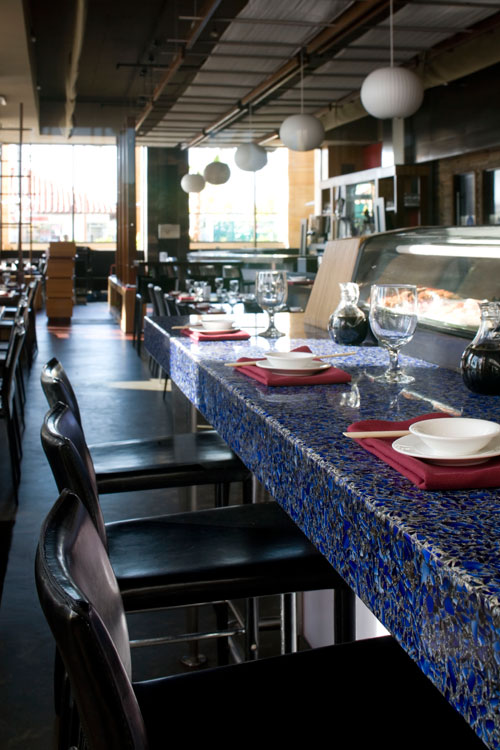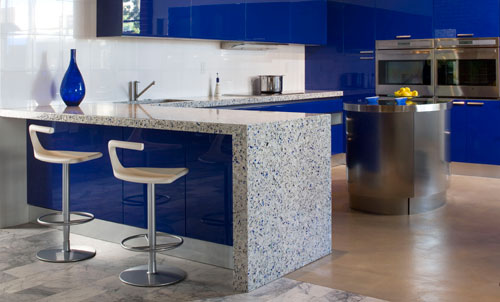Landfill Treasures: Recycling Glass from Trash to Upscale Interior Surfaces
Properties of Waste Glass—Post-Consumer and Pre-Consumer or Post-Industrial
Waste glass is a plentiful resource. Most glass ends up in landfills and approximately 31 percent of glass used in glass surfaces is recycled from collected municipal waste. A glass bottle takes an estimated one million years to decompose. In 2006, approximately six percent of all landfill material was glassiii. Architectural glass makes up one component of the waste stream from all construction debris. There are two main categories of waste glass used in an up-cycled glass surface.
- Post-consumer glass is waste produced by the end consumer of a material.
- Pre-consumer or post-industrial is waste discarded by the manufacturer before it is used and that would not normally be reused by industry in the original manufacturing process
Approximately 13 million tons of glass wastes are generated annually. Food and beverage containers make up over 90 percent of this amount; the remaining 10 percent comes from products like cookware and glassware, home furnishings, and plate glass. Bottles, broken lights and jars from curbside recycling comprise this waste stream. It is sorted into clear, green and amber at Materials Recycling Facilities (MRFs) where it is then resold to manufacturers or other end users. Amber bottles might include beer, root beer, vanilla, medicine and apple juice. In addition to curbside recycling, new practices in the deconstruction of buildings have created a new stream of other post-consumer items besides household objects. These include windows from houses, storefronts and other buildings. Architectural salvage from building demolition can also include decorative glass or glass with unusual textures such as leaded glass windows. Other sources of glass include car windows and windshields (safety glass), traffic light lenses and airport runway lights to name just a few of the more exotic sources of glass waste. Each source tells the story of recycling as well as embedding historic context into the new surface.
Pre-consumer or post-industrial glass provides another unique source for glass bits for use in recycled glass surfaces. In 2011, the EPA reported from a study by the Argonne National Laboratory that more than 60,000 tons of “glass-manufacturing scraps” are generated annuallyv. Although this total may not include all of the scrap that is available for re-use because of a complex accounting formula, it does present a snapshot of the amount glass packaging and other glass scrap available from the manufacturing process that can be used in new products.
Glass manufacturers of bottles, windows and jars are often the source of scrap from imperfect or flawed products. Sometimes these providers can be a source of a specific color or texture of glass that can be easily identified in the new surface. For example, the manufacturer of a distinctive blue vodka bottle resells defective bottles directly from the bottling plant to recycled glass surface manufacturers for up-cycling. In one recycled glass surface there can be as many as 700 bottles and the counter is branded by the distinct color and shape that comes from the source of the recycled product.
 |
Harney Sushi Bar in Oceanside, California, is made from vodka bottles with a distinct color and shape. This durable counter takes a lot of abuse and use in this high traffic club setting yet has maintained its luster and beauty. Photo courtesy of Polycor Vetrazzo Inc. |
Sustainable Manufacturing |
Sustainable products are manufactured by businesses that implement sustainable manufacturing and business practices. Some of the hallmarks of a sustainable manufacturing process for recycled glass manufacturers are:
In addition, a life-cycle analysis of the product is also important so that after manufacturing:
|
Up-Cycling vs. Down-Cycling
Up-cycling reduces the consumption of new raw materials. By choosing a surface that utilized waste glass as its core ingredient, consumers avoid consumption of products like acrylic and quartz surfaces that require binding agent made of petroleum resins, and additionally avoid the need for the mining of other virgin resources typically used in similar installations.
Down-cycling is the process of converting waste materials or useless products into new materials or products of lesser quality or those that are functionally less useful. The quality of the material is decreased and the last iteration of its use is to be discarded as general waste. In down-cycling, the value of the raw material is diminished and it does not maintain its original properties. For example, the use of letter paper as toilet paper is an example of down-cycling. A research study by Lisa A. Skumatz, Ph.D. and Juri Freeman (Skumatz Economic Research Associates, Inc. Superior, CO), titled “What do we do with these piles? Finding alternative uses for glass piles requires a closer look at lower value but cost-effective applications” lists numerous alternatives for the use of glass that is removed from landfills. vi
In comparison, up-cycling conserves all the energy put into the original material; down-cycling reduces the quality of the raw material. Up-cycling uses less energy to achieve a desired product and down-cycling often requires additional energy to create a product.
Recycled glass surfaces are considered up-cycled when they utilize un-melted glass resources. The most sustainable recycled glass sources use verifiable post-consumer and post-industrial glass. Glass that is melted cannot be verified and uses more energy to transform it into a new surface. Post-consumer glass remains the best source in up-cycling because it closes the loop of waste in the materials economy. In fact, the USGBC awards more points in their LEED® program when specifying products that utilize post-consumer content to encourage wider usage.
 |
Heat-resistant, durable and stylish recycled glass surfaces can be used in traditional kitchen countertop applications or add glamour to unexpected spaces like fireplace surrounds. Photo courtesy of Polycor Vetrazzo Inc. |
Post-consumer glass also encourages recycling which in turn adds to new green jobs. It contributes to a developing new domestic market for products that are up-cycled from waste materials. It also conserves energy by using the material as it was originally manufactured while maintaining its performance and performance values.
The architect can identify a post-consumer glass surface by its variation in appearance. Each batch of the product is unique and manufacturers representatives will assist the design professional in selecting a surface that meets their design requirements. If larger selections are necessary, the manufacturer can store a batch run, or even develop a surface to meet the color and schedule requirements of the designer. Post consumer glass has a unique identity and adds value by the story embedded in its surface about the source of this material.









